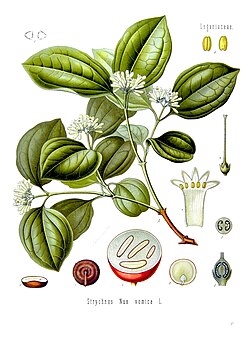| Strychnos | |
|---|---|
 | |
| Strychnos toxifera | |
| Scientific classification | |
| Kingdom: | Plantae |
| Clade: | Tracheophytes |
| Clade: | Angiosperms |
| Clade: | Eudicots |
| Clade: | Asterids |
| Order: | Gentianales |
| Family: | Loganiaceae |
| Genus: | Strychnos L. [1] |
| Species | |
See text | |
| Diversity | |
| c. 200 species | |
| Synonyms [1] | |
| |


Strychnos is a genus of flowering plants, belonging to the family Loganiaceae (sometimes Strychnaceae). The genus includes about 200 accepted species of trees and lianas. [1] The genus is widely distributed around the world's tropics and is noted for the presence of poisonous indole alkaloids in the roots, stems and leaves of various species. Among these alkaloids are the well-known and deadly poisons strychnine and curare.








